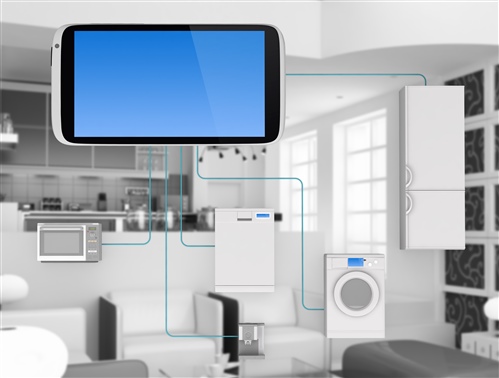SSZT717 May 2018 TPS65217

Remember that game show “Are You Smarter than a 5th Grader?,” in which adult contestants attempted to answer questions from fifth-grade elementary school textbooks? The adults found these questions to be surprisingly challenging. Similarly, the “intelligence” being designed into modern-day appliances is similarly surprising and impressive. Vacuum cleaners, ovens and stovetops, washing machines, air conditioners, lawn mowers, and coffee makers are now evolving into touch-screen-enabled and remotely programmable devices with the ability to monitor and adapt to their environment – capturing surrounding data, making decisions and taking actions based on this data. The days when appliances were simply passive (or “dumb”) devices, used for human controlled and operated daily or weekly chores, are fast becoming a bygone memory.
Intelligent Appliances
Robotic vacuum cleaners are one of the more visible examples of this evolution, as explored in our Achieving increased functionality and efficiency in vacuum robots white paper. These Wi-Fi®-enabled products are programmable on the device itself or remotely via a smartphone. Each new generation of robot vacuums incorporates better tools to increase both cleaning effectiveness (cleaning motors, dirt sensors) and room-mapping and object-circumnavigation efficiency (time-of-flight [ToF] sensors and cameras).
Smart ovens now include human machine interfaces (HMI) and video screens. They also use both internal cameras and temperature probes, among other features. Internal cameras enable users to view the interior of an oven on a display or a smartphone. Employing a camera and video display instead of a see-through glass door increases heat conservation and efficiency. Further, using active temperature-probe monitoring, these ovens can be programmed to turn off and/or notify users when reaching a target temperature.
The latest connected washer and dryer appliances can monitor wash/dry cycles, informing users when clothes are clean or dry, providing usage statistics, and even notifying users when it’s time to order new detergent.
Refrigerators equipped with interior barcode readers connected via Wi-Fi to the internet can inventory their contents and notify users through an HMI display and/or smartphone of expired date codes.
Pod coffee makers enabled with cameras and bar-code readers enable the application of optimum temperature and water flow rate control, depending on the content of the pod (coffee, tea or cocoa).
As a final example, electric robot lawn mowers enable true hands-off yard maintenance, incorporating grass height and rain sensors to optimize operational efficiency. The random mowing pattern algorithms employed by these devices prevent the appearance of lawn mower tracks in the yard. And using sensors and automatically mowing the grass before it gets too high prevents thatch from forming.
TI Technology for Appliances
TI designs microcontrollers, microprocessors, sensors and connectivity devices to address the growing demands of designers and developers in the burgeoning smart appliance market.
TI’s Arm® Cortex®-based Sitara™ processor devices are configured with a variety of flexible peripherals, connectivity and unified software support to cover a wide set of intelligent appliance applications. Specifically, they are designed to interface with various motors, sensors and cameras, and then aggregate and process this data for decision-making and control. Related functions of the processor include HMI (touch-screen displays), graphics/video accelerators, voice command recognition and response using TI digital signal processors (DSPs) and Arm processors, and seamless wireless data communications via TI’s family of WiLink™ 8 devices.
From a software perspective, TI’s Processor software development kit (SDK), which provides a common user interface and software platform for all Sitara devices, enables users to leverage engineering resource investment across multiple Sitara Arm-based processor families.
TI also provides a wide variety of power-management solutions. For example, you could use either a power-management integrated circuit (PMIC) device or a low-cost discrete power solution design to power TI’s AM335x processor which features an Arm Cortex-A8 core.
TI’s broad portfolio of single- and multicore devices affords appliance designers an optimal balance of integrated connectivity and performance for the various demands of the intelligent appliance market. What additional features, functionality and intelligence would you like to see in your appliances?
Additional Resources
- Learn more about TI products in appliances.
- Read Achieving increased functionality and efficiency in vacuum robots white paper.
- Interested in appliances? Read Cut the power and complexity of your appliance designs blog post.